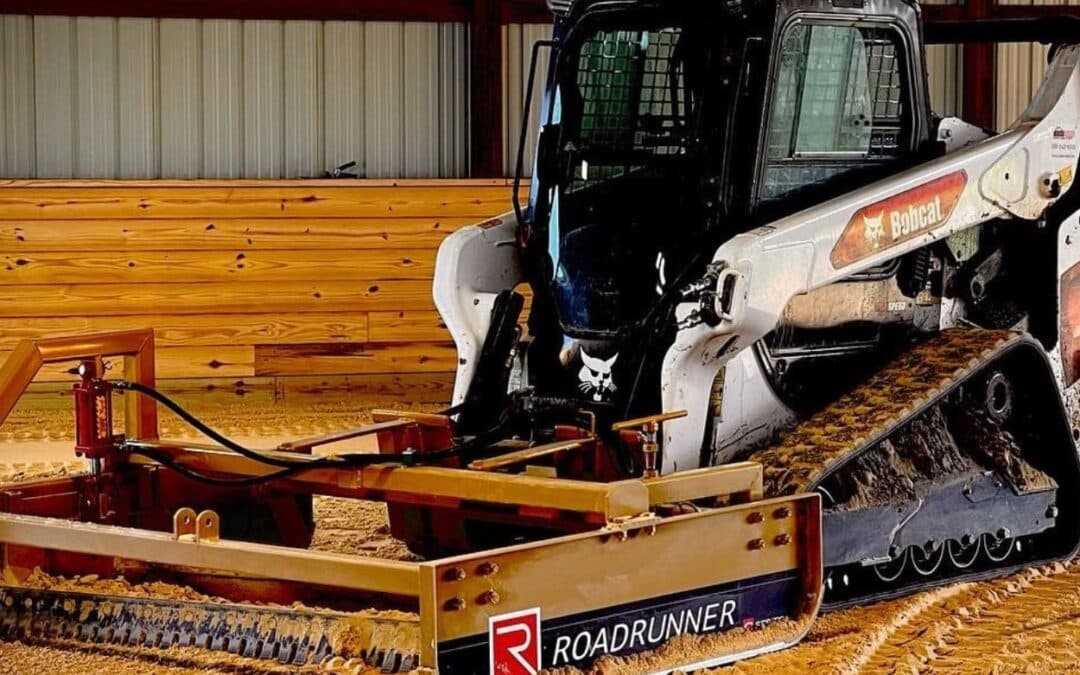Ever felt that sinking feeling of a grader that’s losing its edge – literally? Maybe you’ve noticed uneven surfaces, sluggish response, and the nagging feeling that your machine isn’t quite delivering. These are the telltale signs that your skid steer grader might be crying out for attention.
Whether relying on a seasoned veteran skid steer grader or a shiny new one from a trusted supplier like Roadrunner Equipment, keeping your skid steer grader in top condition can feel like another thing on your already packed plate. We get it! You’re under constant pressure to juggle deadlines, quality, and keeping things running smoothly. Your livelihood depends on the seamless functioning of your equipment, so naturally, maintaining it feels like a daunting responsibility. But don’t let preventable maintenance issues slip, impacting your schedule and the quality you pride yourself on.
This blog post is your go-to guide to keeping your grader happy and your projects on track. We offer comprehensive solutions to all your equipment needs, from maintenance advice to top-range grader attachments. So, let’s get into the nitty-gritty of keeping your grader running efficiently and your operations smooth.
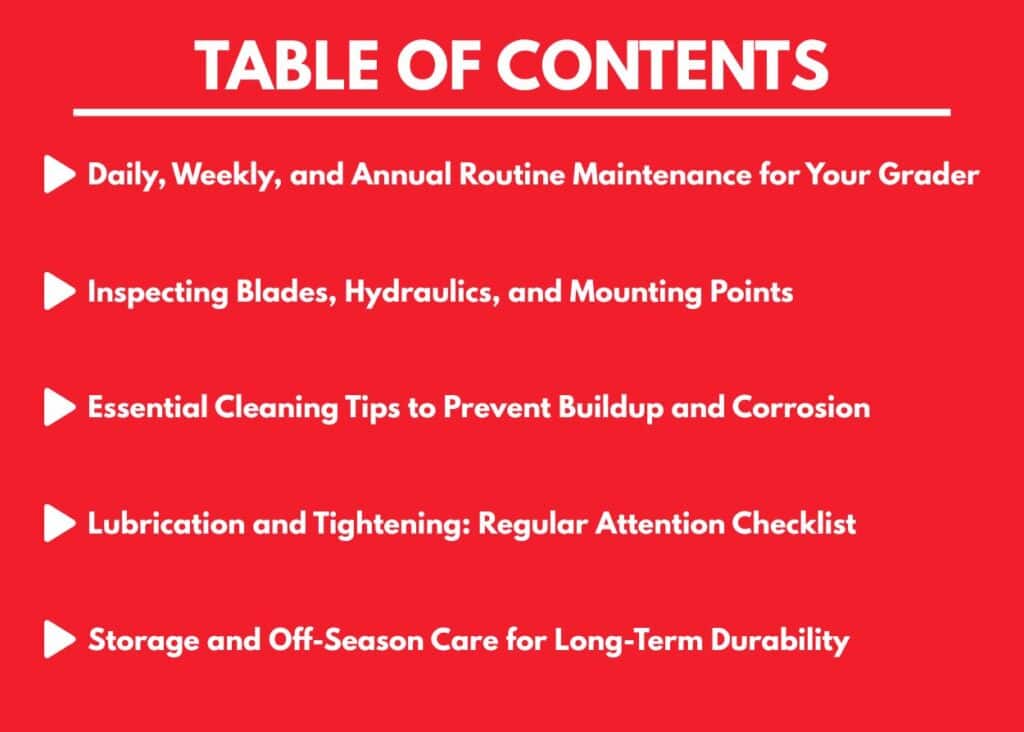
Don’t Have Time to Read? Here’s a Summary
Keeping your skid steer grader in peak condition is all about consistent maintenance and smart habits. Whether you’re running a new Roadrunner Equipment grader or maintaining a trusted workhorse, following a structured maintenance routine saves time, reduces costly downtime, and extends your machine’s lifespan.
Key Takeaways:
-
Daily Checks: Inspect for visible wear, secure pins and clips, grease the height adjustment thread, and confirm all safety systems work properly.
-
Weekly Maintenance: Examine blades for dullness or damage and check skid bars for wear to maintain grading accuracy.
-
Annual Inspections: Tighten all fasteners to spec, check hydraulic hoses and cylinders for leaks or cracks, deep clean the machine, and inspect the frame for structural integrity.
-
Critical Components:
-
Blades — Keep them sharp and even for clean, efficient grading.
-
Hydraulics — Watch for leaks, strange noises, or reduced power output.
-
Mounting Points — Ensure all bolts, bushings, and brackets stay tight and aligned.
-
-
Cleaning Tips: Regularly wash off dirt and mud, dry completely, and apply anti-corrosion coatings to prevent rust and buildup.
-
Lubrication & Tightening: Follow the manufacturer’s guide for greasing all joints; keep bolts and hydraulic fittings snug to avoid vibration and failures.
-
Storage & Off-Season Care: Store indoors or cover well, drain fluids for long breaks, and address small repairs before downtime.
Bottom line:
Preventive maintenance isn’t busywork—it’s the secret to smoother grading, longer equipment life, and fewer breakdowns. Roadrunner Equipment provides expert support, reliable grader parts, and maintenance resources to keep your skid steer grader performing like new.
Daily, Weekly, and Annual Routine Maintenance for Your Grader
Think of your daily and weekly maintenance as your way of showing your grader some love. Just like any piece of hard-working equipment, it thrives on a little TLC. Consistent care ensures consistent performance and extends your equipment’s lifespan.
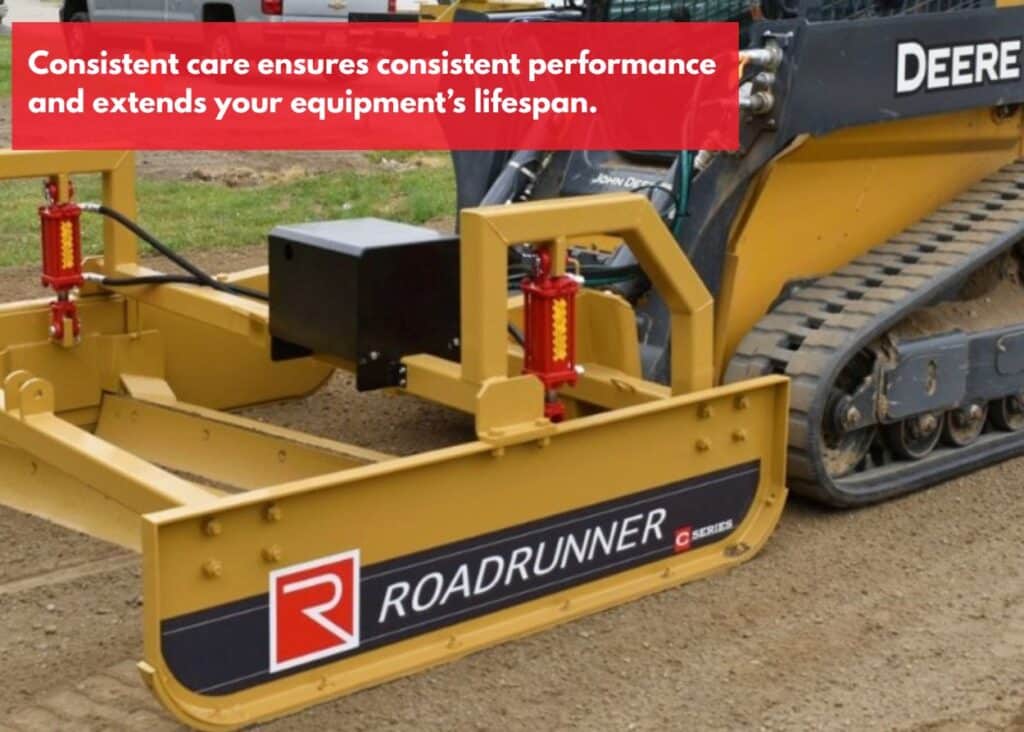
Skipping these checks is like ignoring a small cough that could turn into a full-blown cold – it’ll cost you more in the long run with unexpected repairs and lost work time. Beyond these routine checks, annual maintenance is crucial. This more comprehensive service involves in-depth inspections and adjustments to prevent major issues. Ultimately, preventative maintenance is an investment, not an expense. Let’s look at some simple habits that make a big difference.
Daily Routine
Daily checks should become second nature. Before operating your grader, check for any visible wear, damage, or loose components. Make sure all attachment points are secure and free of wear, and ensure the grader is securely attached to the skid steer. A quick once-over can prevent major issues down the line.
Key Daily Tasks:
- Retainer clips and pins: Make sure all retainer clips and pins are in place to secure components and prevent unexpected disconnections.
- Height adjustment linkage: Perform a visual inspection of the height adjustment linkage for wear and debris. Clear any obstructions and note any signs of wear that could affect performance.
- Height adjustment thread: Don’t forget to grease the height adjustment thread. This keeps it moving freely and prevents seizing.
- Safety first: Make sure all your safety gadgets – lights, alarms, controls – are working like they should. It’s not worth taking a chance.
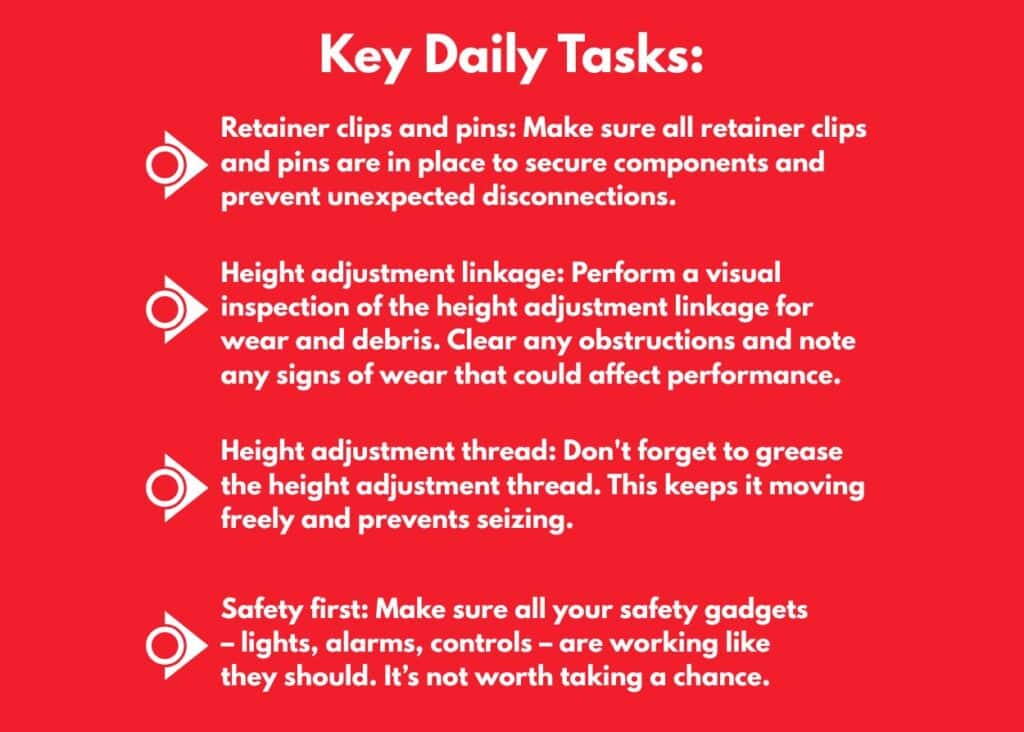
Weekly Routine
Weekly maintenance dives deeper, ensuring performance remains uncompromised. This routine is essential for identifying and addressing issues that aren’t apparent during daily checks, keeping your grader in top condition.
Key Weekly Tasks:
-
- Inspect the Blades: These are your grader’s workhorses! Check for any nicks, dull spots, or damage. A sharp blade makes all the difference – using a dull blade is like trying to cut steak with a butter knife.
- Check the Skid bars: Inspect skid bars thoroughly for any signs of wear, as excessive deterioration can significantly impact grading accuracy and machine stability.
Annual Routine
An annual inspection goes beyond routine cleaning and quick glances, delving into the core components that keep your machine running smoothly.
Key Annual Tasks:
-
- Tighten Up: Just like a good workout, your grader’s parts can loosen up over time. During the annual inspection, it’s crucial to make sure all fasteners are tightened to their proper torque. This keeps everything secure and prevents unexpected wobbles or worse.
- Hydraulic System: Your grader’s hydraulic cylinders and hoses are its muscles and veins. You’ll want to inspect them for any signs of damage – think cracks, leaks, or even just general wear and tear. Spotting these issues early can save you from a major hydraulic failure down the road.
- Thorough Cleaning: Before you get into the nitty-gritty, give your grader a truly thorough wash. Getting rid of all that built-up dirt and grime isn’t just about looking good; it actually helps you see potential problems like small cracks or leaks that might be hidden otherwise. A clean machine is an honest machine!
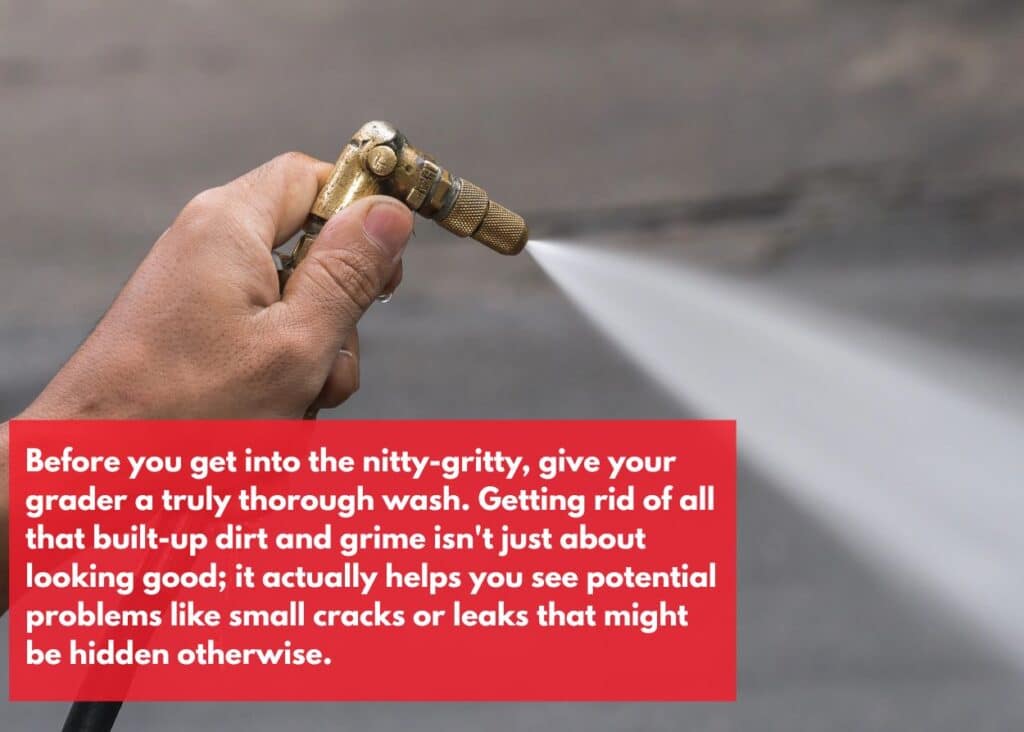
- Frame Integrity: Your grader’s frame is its backbone. You’ll want to inspect it closely for any signs of cracking or damage. Even tiny hairline cracks can expand with constant use, potentially leading to big structural problems. Taking the time to look now can prevent a catastrophic failure and keep your grader on the job.
Inspecting Blades, Hydraulics, and Mounting Points
Think of your skid steer grader attachment like a trusty sidekick. It’s got key parts that really take a beating and need our attention to keep going strong. We’re talking about the blades that bite into the ground, the hydraulic muscles that power everything, and those solid mounting points that keep it all connected. Let’s dive into each one.
Blades
The blades are what make your grader do its job right. Imagine trying to smooth out a gravel driveway with something blunt – frustrating, right? That’s what happens when your blades get nicked up, bent, or just plain worn down. A sharp, even blade is like having a brand-new razor blade – it slices through the material cleanly and efficiently. If you let those edges go, you’ll end up with uneven surfaces, take way longer to get the job done, and might even put unnecessary stress on the rest of your machine. Before starting any grading job, give those blades a quick once-over. It takes a minute, but it saves a ton of headaches later.
Hydraulics
Now, let’s talk about the hydraulic system – the very veins and arteries of your grader. If these aren’t in good shape, nothing else works properly. Listen closely: if you hear any weird whining or hissing sounds coming from your hydraulic system, that’s often your machine trying to tell you something’s not right.
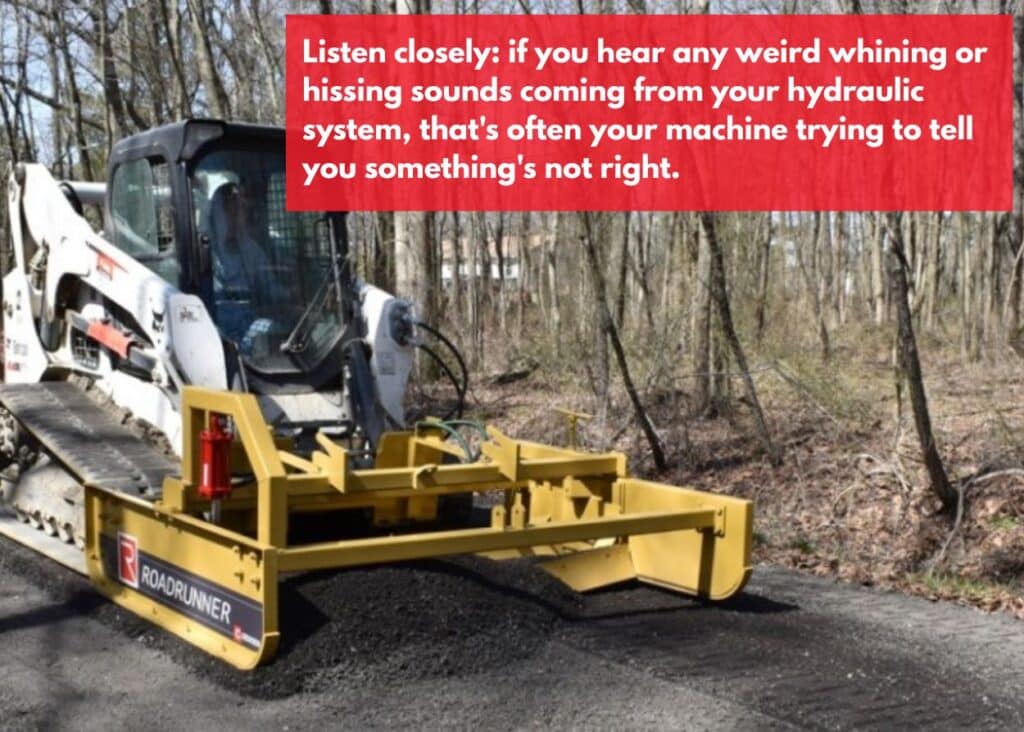
Keep an eye out for any leaks. Even a small drip can turn into a big problem if you ignore it. Hydraulic fluid is precious (and expensive!), and leaks mean lost power and potential damage. (Pro tip: Having a basic spare parts kit for your hydraulics can be a real lifesaver on a busy day.)
Mounting Points
Think of the mounting points as the structural backbone of your attachment. You want that connection to be solid and secure, right? Before you start each day, give those bolts, brackets, and pins a good visual check. Make sure nothing looks loose or out of alignment. Loose connections cause all sorts of problems, from wobbly performance to, worst case scenario, something coming completely undone. Keep those bolts tightened! If you see any pins or bushings that look worn or have play in them, replace them ASAP. Ignoring these is like driving with a loose wheel – it’s just asking for trouble. A quick check of those mounting points before you get going can prevent accidents and ensure a smoother, safer workday.
Essential Cleaning Tips to Prevent Buildup and Corrosion
Let’s talk about keeping your grader looking good and working even better: cleaning! It might seem like a chore, but it pays off big time. All that dirt and grime that builds up can cause rust and wear down parts faster than you think. Plus, let’s be honest, a clean machine just looks more professional.
A monthly wipe-down of key areas followed by a more thorough annual clean is ideal. Use appropriate cleaning products and tools to avoid damaging sensitive components.
- Use High-Pressure Washers: These are great for blasting away caked-on mud and dirt, especially in those hard-to-reach spots.
- Dry Thoroughly: Always make sure to dry your grader thoroughly after washing it. Water hanging around is just asking for rust to set in.
- Apply Protective Coatings: Consider using anti-corrosive sprays on metal surfaces – it’s like giving your machine a little extra layer of defense.
These routine cleaning practices can drastically prolong the life of your grader attachments, maintaining their pristine condition over time. Remember, a clean machine is a happy machine that will have fewer issues and last longer.
Lubrication and Tightening: Regular Attention Checklist
Okay, let’s talk about keeping things moving smoothly – and that means lubrication and tightening. Think of it as giving your grader a good stretch and making sure all its joints are working freely.
Lubrication Tips:
- Read the manual! Seriously, your manufacturer knows best when it comes to the right type and amount of grease.

- Hit all the spots: Make sure you’re greasing all those pivot points and joints regularly, just like the manual says.
- More isn’t always better: Too much grease can actually attract dirt and make things worse.
A little grease adds years to the life of your grader. Skipping this is like running an engine without oil – bad news!
Regular Tightening:
Loose bolts and connections are like having a wobbly wheel – they cause all sorts of problems. Make it a habit to tighten up those bolts, fasteners, and connectors. Don’t forget to make sure those hydraulic lines are securely fastened. Leaks here can be a real headache. Get yourself a good set of wrenches – it makes the job easier and safer.
Bottom Line: Keeping things tight means smoother operation and fewer unexpected breakdowns.
Storage and Off-Season Care for Long-Term Durability
Proper storage is crucial when your grader needs some downtime, whether just overnight or for the whole off-season. Giving it a good “rest” is important for long-term health.
- Choose the right spot: Think of it like finding a cozy place for your machine to sleep. A clean, dry spot away from direct sun, rain, and extreme temperatures is ideal.
- Cover it up! If you can’t store it inside, a good, sturdy tarp is like a blanket for your grader, keeping out dust and moisture.
- Off-season prep: Before you tuck it away for a longer break:
- Drain those fluids: This prevents them from degrading and causing problems down the road.
- Give it a good once-over: Now’s the time to fix any little issues you’ve noticed. You don’t want them getting worse while it’s sitting idle.
Taking these precautionary steps means your grader will be raring to go when you need it again, saving you time and getting you back to work faster.
Conclusion
So, the next time you wrap up a grading job, remember the work isn’t quite done. Taking those extra few minutes for inspection, lubrication, and cleaning makes all the difference. Trust us, these aren’t just chores – they’re investments in keeping your operation smooth and giving you one less thing to worry about. Invest in preventative maintenance for your skid steer grader and reap the rewards! It’s about working smarter, not just harder.
When it comes to reliable equipment performance and longevity, choosing the right partner for your grader needs is as important as maintenance itself.
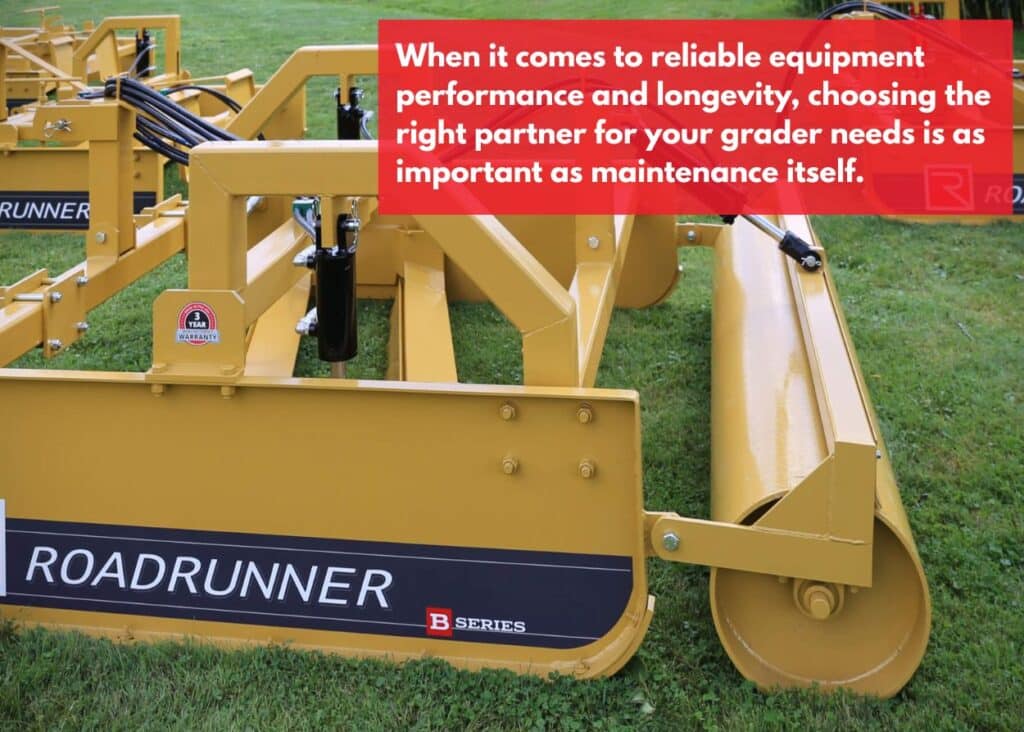
Our team at Roadrunner Equipment is committed to helping you get the most out of your skid steer grader, from offering advice like this article to providing the right parts and services to keep you up and running.
Want more tips and tricks for getting the most out of your skid steer grader? Check out these other blogs for helpful information on using your skid steer grader:
- Why Gravel Roads Need Grading
- 11 Dirt Surfaces That Benefit from Grading
- How to Crown a Gravel Driveway
- Gravel Driveway Maintenance: Spring and Summer
Contact us today! We look forward to hearing from you!

